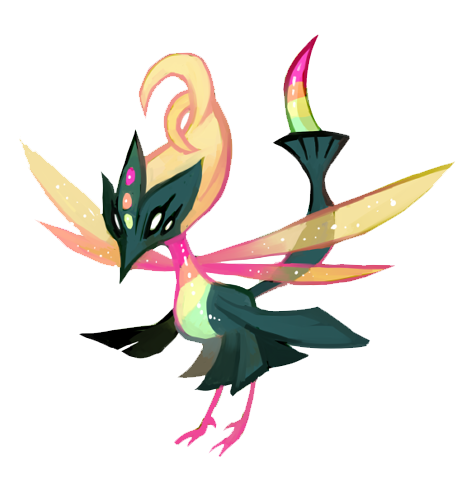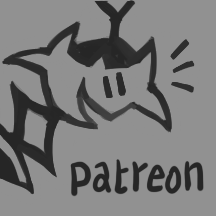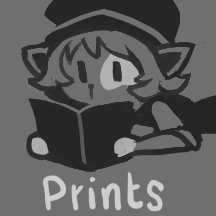Changeling

A parasitic species that infects children using the tail stinger. Changeling children look no different from normal children until maturation approaches - then, the changeling begins to develop a colorful carapace and stinger. Very often changelings prefer to parasitize intelligent species. They also prefer bugs and avian critters so that they blend in better.
Common locations: Changelings are native to Owel, though they claim no particular place of origin. Many suspect they originated in Heaven’s Keys, due to their strange magic and lifestyle, but most Changelings will reject this as a blind assumption made about a species that is maligned and misunderstood. Despite their parasitic nature, Changelings often keep to themselves, travelling in ramshackle caravans all around Owel and setting up camps wherever they won’t be immediately evicted. They are drawn to populated areas despite the fact that they are rarely welcomed into such locations.
Climate preference: Different bands of Changelings favor different migration routes, but in general their climate preference is dictated by their host species. Changelings are generally tolerant of all but the most extreme climates.
Ability to Plan/Abstract: Changelings always do their best to parasitize sentient species, thus producing sentient offspring, but sometimes mistakes are made or the dice are rolled differently. Most nonsentient Changelings are sickly and do not survive, but robust specimens can become formidable threats, as their instinctive desire to change the world around them is unhindered by their lack of higher-level thinking.
Language: Whatever language they spoke growing up; as time passes they will gain a strong aptitude for Fae, and Changelings that live amongst other Changelings will pick it up extremely quickly.
Elements
Common: A Changeling’s affinity depends strongly on the base species it is grown from and the environment it is raised in, in general falling in line with the elemental tendencies of that species. However, Changeling children that are not naturally aligned with Spirit or its subtypes will begin to develop one as a secondary element when their stinger begins to grow (sometimes, even Spirit-aligned Changelings will still develop additional Spirit affinities, which can lead to a volatile and potentially fatal mix of magic). This appears to be an integral part of the species, as Changelings without Spirit or its subtypes seem always to die young, wasting away with no obvious illness or condition to blame.
Hereditary magic: Changelings are all naturally skilled, to some extent, in transformative magic. Interestingly, this inherent desire to alter the world around them seems to occur regardless of the elemental affinity of the Changeling; an Air affinity Changeling may find themselves slowly eroding away at their targets, their alterations slow and difficult to pattern, while a Lava affinity Changeling may instead find it easier to break things down into a slurry of potential that can be shaped back together with care. While all known Changelings possess a Spirit affinity or one of its subtypes, it is uncertain if this in itself is responsible for their ability to introduce change and abnormalities into their victims, though it certainly does aid in accomplishing this goal.
Weaknesses:
Light, Psi: While not true magical weaknesses, the survival of a Changeling until their maturation relies heavily on the ability to obscure their true nature until they are able to forsake their host family. Any innate ability to reveal, dispel, or comprehend what they are before that point greatly endangers them, and Changelings tend to avoid parasitising species with affinities or natural abilities that might compromise the survival of their offspring.
Beyond this, the elemental weaknesses of the individual are based largely on those of the base species.
Resistances:
Spirit: Changelings welcome Spirit and the alterations in can bring to them and the world around them. Even if it warps their own bodies or minds, it tends to do so to a much smaller extent than one might expect, perhaps due to how altered they are to begin with. Occasionally, however, a Changeling will have an extreme weakness to Spirit, often if they have more than one of Spirit or its subtypes as an affinity. In cases like that, they are in danger of being completely unravelled by its abilities.
Similar to their weaknesses, the resistances of a Changeling depend on the species they are formed from.
Trivia
-
All Changelings describe a “Calling” when they come of age, a compelling force that drives them to forsake their homes and wander the world in search of others of their kind. Most agree that their childhood was spent with an ever-lingering sense of not belonging, sometimes impacting their relationships with others. Changelings are, contrary to many old tales and folk traditions, entirely physically indistinguishable from other children of their species, up until they begin developing the hallmark stinger that will give them away and that apparently coincides with the Call they begin to feel.
-
It’s impossible to say what a Changeling would look like without parasitizing another species, but there are some traits shared across all Changelings that hint at some sort of core appearance. Changelings will almost always develop at least a partial carapace over their body, sometimes fully replacing the fur, scales, or skin beneath it, and it is usually colorful and irridescent.
-
As previously mentioned, the stinger seems integral to a Changeling’s development; removing it will cause their death. If their host species already has a stinger, such as Manticores, the existing stinger will either change over time into one matching the more typical features of a Changeling, or will fall off and be replaced by a new one. The change is similar for existing carapaces or shells of insectoid species.
-
Changelings also seem to have a tendency towards avian features, with beaks, feathers or feather-like growths, and talons often forming regardless of the host species’s original features.
-
Manticores, Cockatrices, Pygmy Pyzkyes, and insect species are the ones most commonly parasitized, since their features align with those of Changelings enough that their transformation can go unnoticed for far longer; in rare cases, fully grown Changelings can pass fully for their host species, by virtue of shared traits.
-
Most Changelings congregate in groups that live on the fringes of civilization, always travelling from one place to the next in search of areas they might leave an impact on, good or bad. Sometimes, Changelings will set off on their own, usually if they can pass for another species, as clear Changelings are discriminated against and distrusted due to their tendency to cause trouble or change wherever they go.





![[Beleth looking bored]](https://floraverse.com/static/images/global-title-foreground-left.png)

![[Andre looking proud of his graffiti]](https://floraverse.com/static/images/global-title-foreground-right.png)






